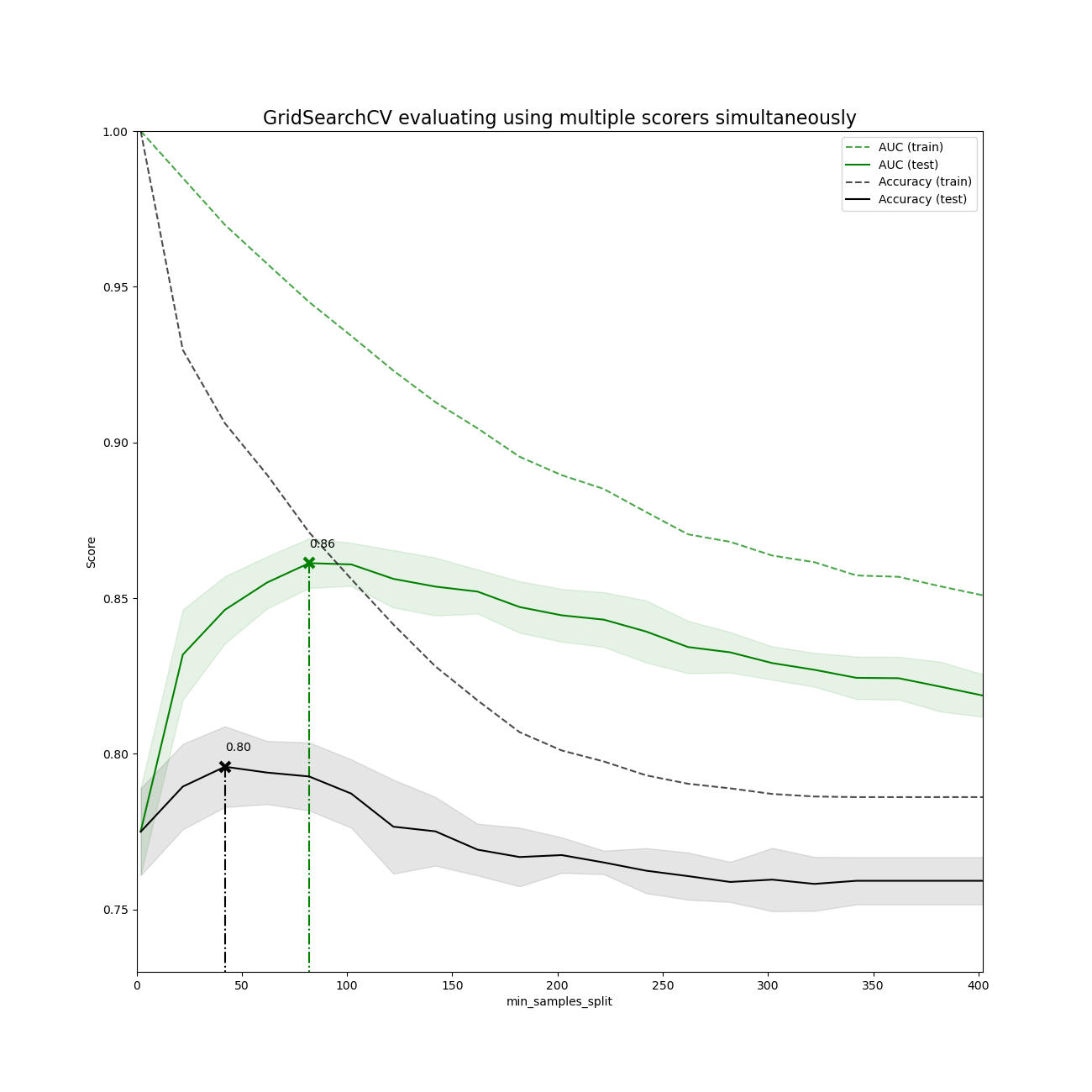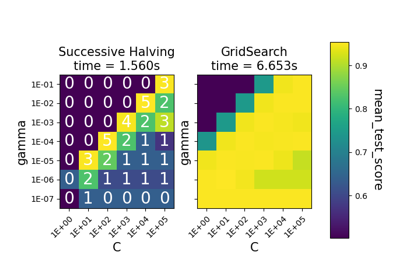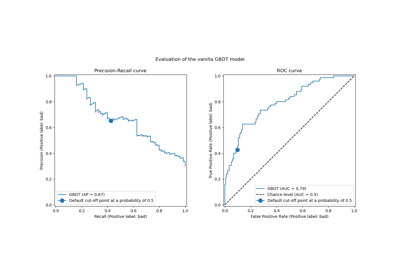注意
转到末尾 下载完整的示例代码或通过 JupyterLite 或 Binder 在浏览器中运行此示例。
在 cross_val_score 和 GridSearchCV 上演示多指标评估#
通过将 scoring 参数设置为指标评分器名称列表或将评分器名称映射到评分器可调用对象的字典,可以进行多指标参数搜索。
所有评分器的分数都可以在 cv_results_ 字典中找到,其键以 '_<scorer_name>' 结尾('mean_test_precision'、'rank_test_precision' 等…)
best_estimator_、best_index_、best_score_ 和 best_params_ 对应于设置为 refit 属性的评分器(键)。
# Authors: The scikit-learn developers
# SPDX-License-Identifier: BSD-3-Clause
import numpy as np
from matplotlib import pyplot as plt
from sklearn.datasets import make_hastie_10_2
from sklearn.metrics import accuracy_score, make_scorer
from sklearn.model_selection import GridSearchCV
from sklearn.tree import DecisionTreeClassifier
使用多个评估指标运行 GridSearchCV#
X, y = make_hastie_10_2(n_samples=8000, random_state=42)
# The scorers can be either one of the predefined metric strings or a scorer
# callable, like the one returned by make_scorer
scoring = {"AUC": "roc_auc", "Accuracy": make_scorer(accuracy_score)}
# Setting refit='AUC', refits an estimator on the whole dataset with the
# parameter setting that has the best cross-validated AUC score.
# That estimator is made available at ``gs.best_estimator_`` along with
# parameters like ``gs.best_score_``, ``gs.best_params_`` and
# ``gs.best_index_``
gs = GridSearchCV(
DecisionTreeClassifier(random_state=42),
param_grid={"min_samples_split": range(2, 403, 20)},
scoring=scoring,
refit="AUC",
n_jobs=2,
return_train_score=True,
)
gs.fit(X, y)
results = gs.cv_results_
绘制结果#
plt.figure(figsize=(13, 13))
plt.title("GridSearchCV evaluating using multiple scorers simultaneously", fontsize=16)
plt.xlabel("min_samples_split")
plt.ylabel("Score")
ax = plt.gca()
ax.set_xlim(0, 402)
ax.set_ylim(0.73, 1)
# Get the regular numpy array from the MaskedArray
X_axis = np.array(results["param_min_samples_split"].data, dtype=float)
for scorer, color in zip(sorted(scoring), ["g", "k"]):
for sample, style in (("train", "--"), ("test", "-")):
sample_score_mean = results["mean_%s_%s" % (sample, scorer)]
sample_score_std = results["std_%s_%s" % (sample, scorer)]
ax.fill_between(
X_axis,
sample_score_mean - sample_score_std,
sample_score_mean + sample_score_std,
alpha=0.1 if sample == "test" else 0,
color=color,
)
ax.plot(
X_axis,
sample_score_mean,
style,
color=color,
alpha=1 if sample == "test" else 0.7,
label="%s (%s)" % (scorer, sample),
)
best_index = np.nonzero(results["rank_test_%s" % scorer] == 1)[0][0]
best_score = results["mean_test_%s" % scorer][best_index]
# Plot a dotted vertical line at the best score for that scorer marked by x
ax.plot(
[
X_axis[best_index],
]
* 2,
[0, best_score],
linestyle="-.",
color=color,
marker="x",
markeredgewidth=3,
ms=8,
)
# Annotate the best score for that scorer
ax.annotate("%0.2f" % best_score, (X_axis[best_index], best_score + 0.005))
plt.legend(loc="best")
plt.grid(False)
plt.show()

脚本总运行时间: (0 minutes 9.662 seconds)
相关示例



